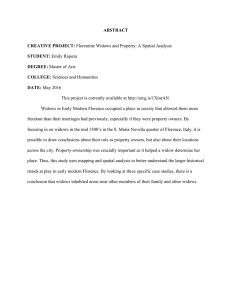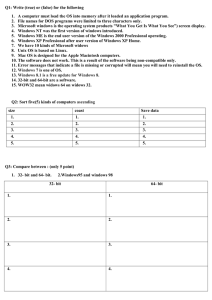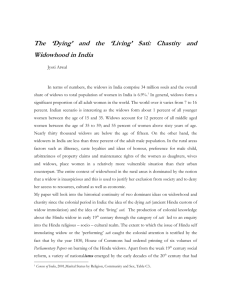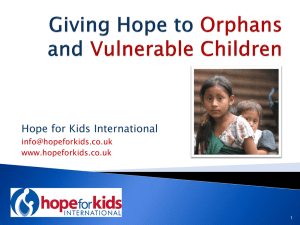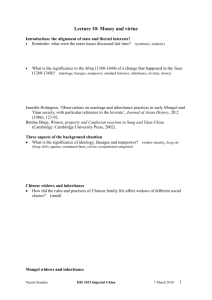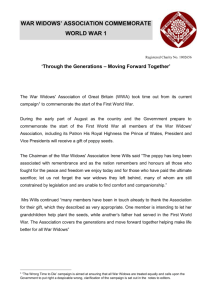WIDOWHOOD PRACTICES IN NIGERIA AND SUPPORT SYSTEMS: CHALLENGE TO BY
advertisement
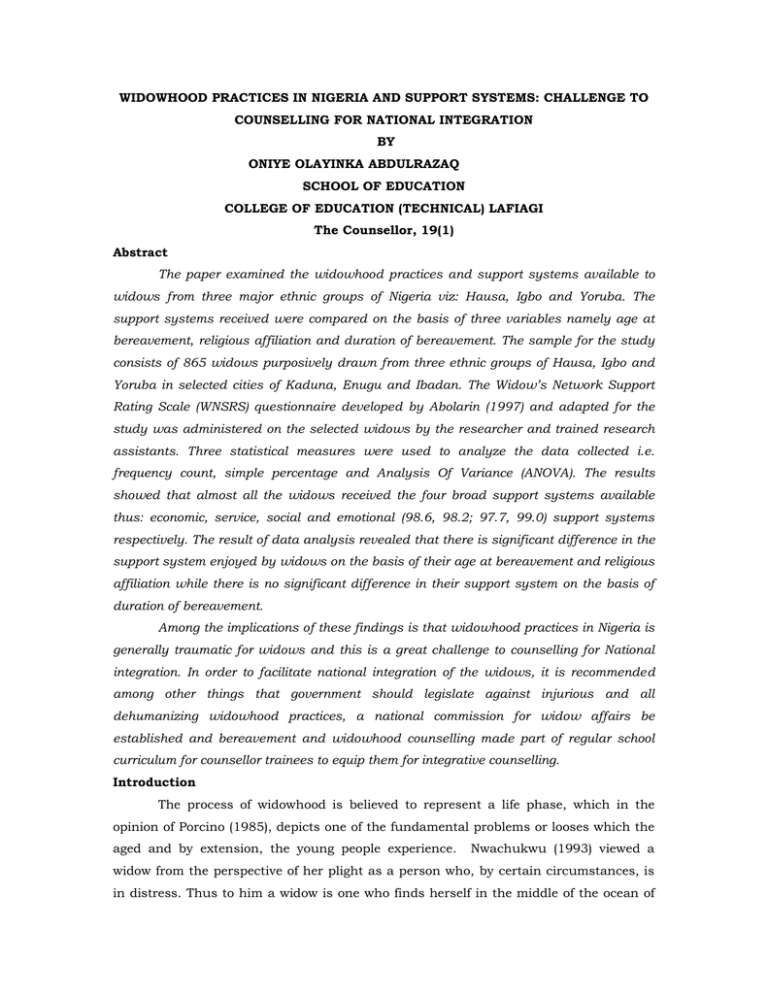
WIDOWHOOD PRACTICES IN NIGERIA AND SUPPORT SYSTEMS: CHALLENGE TO COUNSELLING FOR NATIONAL INTEGRATION BY ONIYE OLAYINKA ABDULRAZAQ SCHOOL OF EDUCATION COLLEGE OF EDUCATION (TECHNICAL) LAFIAGI The Counsellor, 19(1) Abstract The paper examined the widowhood practices and support systems available to widows from three major ethnic groups of Nigeria viz: Hausa, Igbo and Yoruba. The support systems received were compared on the basis of three variables namely age at bereavement, religious affiliation and duration of bereavement. The sample for the study consists of 865 widows purposively drawn from three ethnic groups of Hausa, Igbo and Yoruba in selected cities of Kaduna, Enugu and Ibadan. The Widow’s Network Support Rating Scale (WNSRS) questionnaire developed by Abolarin (1997) and adapted for the study was administered on the selected widows by the researcher and trained research assistants. Three statistical measures were used to analyze the data collected i.e. frequency count, simple percentage and Analysis Of Variance (ANOVA). The results showed that almost all the widows received the four broad support systems available thus: economic, service, social and emotional (98.6, 98.2; 97.7, 99.0) support systems respectively. The result of data analysis revealed that there is significant difference in the support system enjoyed by widows on the basis of their age at bereavement and religious affiliation while there is no significant difference in their support system on the basis of duration of bereavement. Among the implications of these findings is that widowhood practices in Nigeria is generally traumatic for widows and this is a great challenge to counselling for National integration. In order to facilitate national integration of the widows, it is recommended among other things that government should legislate against injurious and all dehumanizing widowhood practices, a national commission for widow affairs be established and bereavement and widowhood counselling made part of regular school curriculum for counsellor trainees to equip them for integrative counselling. Introduction The process of widowhood is believed to represent a life phase, which in the opinion of Porcino (1985), depicts one of the fundamental problems or looses which the aged and by extension, the young people experience. Nwachukwu (1993) viewed a widow from the perspective of her plight as a person who, by certain circumstances, is in distress. Thus to him a widow is one who finds herself in the middle of the ocean of life, struggling to survive. Technically, a widow is a woman who survives her husband and has not remarried (Oniye 2000). Abolarin (1997) defined widowhood as the state of mourning the loss of one’s husband or wife through death. The stress of this phenomenon is as real as those of loneliness and divorce. Widowhood is thus seen as a life event with wide range of consequences. For instance, widowhood is known to be responsible for the poor health status of widows and widowers, with minimal long-term consequences (Ferraro, 1985). Widowhood is also associated with intense grief and anger expression, especially among more widows than the divorced (when) compared (Kitson & Zyganki, 1987). This is possibly because of deprivation following loss of spousal intimacy through death. It can thus be concluded that widowhood by implication is a stressful life event demanding practicable support systems. In the opinion of Goldman and Lord (1983) mourning and widowhood are opposite sides of the same coin with wide range of implications for those affected. Gbenda (1997) has observed that widowhood is an issue that affects more women than men. Evidence, he noted, indicates that over the long-term women are affected more severely than men financially, psychologically, sexually and socially. For instance issue of mourning and widowhood process in Nigeria is surrounded by a number of cultural expectations. It has been observed that widowhood in Nigeria is a sordid situation which merely allocates to the widow a position of societal scorn, disdain and permanent membership of the wretched of the earth (Babangida, 1988). In the Northern region of Nigeria, attribution of death is to God and the widow traditionally is expected to mourn her late husband (tabaka) for a specified period of time. The mourning period is four lunar months plus ten day and till the day of delivery or weaning of her new baby for a widow not pregnant before the death of her husband and the pregnant widow respectively. The widow after the mandatory mourning period could stay and remarry in the same family or go elsewhere for the same purpose. However, except that most widows are often neglected during and after mourning together with their children there is no any other practice of mourning that is physically injurious or degrading to the widow. In order to survive the harsh financial situation faced thereafter most widows are known to take to petty trading, begging for alms or other survival strategies to keep body and soul together (Kabir, 1991). The situation of widows from the Eastern region is not that hopeful because the underlying assumption concerning the mourning rites practiced in this region is that the wife has been contaminated by the death of her husband. Thus, in order to be cleansed of this ‘dirt’ for normal interaction with members of the society, a number of mourning rites/traditions are prescribed such as wailing profusely immediately after the death of her husband, the widow is also kept with the corpse of her husband before burial to keep away flies from the body of the dead husband; waking the household with her wailing which is measured as adequate or otherwise by the junior relations of her dead husband (the Umuada) among others. Nwoga (1989) noted that the rule of the process does not permit the widow to talk to any man, cook her food or do any work. Thus, Okonjo (1992) posited that the poor widows spend all their resources and incur debts in order to give a befitting burial to their husbands. In essence, this widows’ maltreatment and impoverishment in contemporary Nigeria is a function of how empowered educationally and economically the women affected are as well as that of their age and location. According to Oloruntimilehin (1991), confinement is a common feature of mourning practice for widows in the Western region. He noted that while two-three weeks is the duration for employed widows, unemployed widows are expected to use forty-days. During this period, the relation of the late husband jointly provide ‘caretaker’ services to the widow, the period is climax zed by the observance of a night of vigil by the widow, her relations, friends, and those of her late husband. It is however, a bad fate for a widow to die on such a night as she would be presumed to be responsible for her husband’s death. The widow starts the second phase of her mourning by getting out early the next morning knocking the door of her neighbours to thank them for their care and concern. Traditionally, these neighbours are neither expected to reply nor show their face in acknowledgement. However, in some other parts of the western region, attribution of a husband death is culturally made to the wife. In order to vindicate herself, she is expected to drink successfully from the water used for bathing the corpse of her deceased husband, thus, according to Owosanoye (1997), the trauma associated with widowhood is a well recognized phenomenon especially among women. These practices by all purposes and intent are contrary to universal religious injunctions. These practices regrettably, are another aspect of discrimination against women generally in spite of the growing popularity of the legal principle that “women rights are human rights” (Olusakin, 1998). Support is any object or action or instruction that the receiver and/or the giver accept as being necessary or helpful in maintaining a life style. This definition considering the multidimensional nature of deprivation inherent in widowhood is broad based and all embracing of the various elements of support programme (Lopata, 1988). Support generally has been classified into four main groups as economic, service, social and emotional component of similar nature or outlook. For example, service is support system including such things as transportation, house repair, house keeping, childcare and provision of legal aid etc, support network is however used here to refer to all those people and groups who provide support to the widow like relatives, friends, co-workers, religious bodies etc. The death of a husband who is suppose to be the bread provider for the wife, automatically, exposes the widow to lots of financial, social, physical, sexual, emotional and societal difficulties (Abolarin, 1997, Oniye, 2000). According to Second king 4:1 and the Holy Quran 4:24, religiously it is the marital role expectation of the husband to provide financial and other support for the wife to the extent that the wife may be completely dependent on the man. Thus, with his ultimate death, a provider’s vacuum is created, which by implication necessitates the provision of such supports by welldefined support networks. This “vacuum filling” is necessary in order to alleviate the attendant suffering of the widow who might, consequently became confused, helpless and frustrated (Sanders, 1980).Rooks (1987), observed that the functions of support system to widow include restoring widow’s confidence and sense of belonging often accomplished through the availability close and intimate relationship between the widow and the significant others in her life. However for any support system to be effective it must met at least four conditions namely adequate and proportional to perceived need, timing must be appropriate and prompt, it must be genuine without any degrading or insulting conditions attached; and practicable in its structure. However, there exists individual difference and socio-cultural variation in the amount of support systems received by a widow and provided or to be provided by the identified support network. It is contended that majority of the widow received general support from most of the network. Specifically economic support is given to most widows mainly by their siblings, female friends and husband’s friends. Service support is provided by widow’s siblings, children and female friends. The same support network provides the widow with social and emotional support systems. It can thus be said that at least five main factors usually determine the type and amount of support system received or given to the widow. These are the marital or parental ethnic background of the widow, her age at bereavement (whether she could still give birth or not), duration of widowhood marital status and childliness or childlessness (Abolarin 1997). Categorically, it has been observed that younger widows were mostly supported by their husband’s relations, while older widows got their own support mainly from their siblings and children. As for the childless widows, they were mostly, supported by their relations. It has also been found that as the length of widowhood increases the amount and/or frequency of economic support given decrease. Statement of the problem It is believed that the pathetic state of widows is made difficult by some cultural expectations/deprivations associated with the phenomenon (Osarenren, 1998). The importance of support systems in alleviating the sufferings of widows has been emphasized by researchers like Abolarin (1997). Wiebe (1987) and Lopata (1979). It is however observed that some of these works are foreign based and their findings could not be wholly transferred to meet Nigeria situations. With respect to the work of Abolarin, it is Nigeria based, however with emphasis on support network alone. Thus this present study seeks to examine the widowhood practices of three major ethnic groups in conjunction with the support systems received. Secondly, the study seeks to examine the relative influence of the variable mentioned earlier as they relate to the type and amount of support systems received by Nigerian widow from the three main ethnic groups of Hausa, Igbo and Yoruba. Research Questions (i) What are the support systems available to Nigerian widows? (ii) Is there any difference in the support systems received by Nigerian widows on the basis of their age at bereavement? (iii) Is there any difference in the support systems received by Nigerian widows on the basis of their religious affiliation? (iv) Is there any difference in the support system received by Nigerian widows on the basis of duration of their bereavement? Research Hypotheses 1. There is no significant difference in the support systems enjoyed by Nigerian widows on the basis of their age at bereavement. 2. There is no significant difference in the support systems enjoyed by Nigerian widows on the basis of their religious affiliation. 3. There is no significant difference in the support system enjoyed by Nigerian widows on the basis of duration of their bereavement. Methodology The research design adopted for this study is the descriptive survey method which according to Kerlinger (1978) is a research approach that focuses on people and their beliefs, opinion etc. Therefore to understand the opinion of Nigerian widows on the nature and amount of support systems received, the choice of the descriptive survey appears appropriate. The sample for the study was made up of 865 widows purposively sampled from the three major ethnic groups of Hausa, Igbo and Yoruba in three selected cities of Kaduna, Enugu and Ibadan. The Widows Support Network Rating Scale (WSNRS), developed by Abolarin (1977) was the instrument adapted for the study. the instrument was made up of sections A and B while section A seeks demographic data of the respondents, section B contains support systems for widows and it is grouped into four main components; (a) economic (b) service (c) social and (d) emotional support system. The instrument was jointly administered by the researcher and trained research assistants on the widows in their working places and at religious gatherings. The data collected was analyzed using three statistical measures of frequency count, simple percentage and Analysis Of Variance (ANOVA). Table 1: Distribution of respondents by Age Religious Affiliation and Duration of Bereavement Variables No. of respondents Percentage 25-35years 235 17.2 36-55years 366 42.3 56years & above 264 30.5 Total 865 100.00 No of respondents Percentage 338 39.1 498 57.6 Others 29 3.3 Total 865 100.00 No of respondents Percentage 2-5 years 397 46.0 6-11 years & above 468 54.0 Total 865 100.00 Age at bereavement Variables Religious affiliation Islam Christianity Variables Duration of bereavement Results The results of the data analysis are presented in three parts namely (a) demographic data on the main research questions, (b) report of hypotheses tested and (c) summary of findings. Table 2: Distribution of respondents by Support Systems Variables No of respondents Percentage Economic support system 853 98.6 Service support system 850 98.2 Social support system 845 97.7 Emotional support system 856 99.0 Support system Table 2 shows that out of 865 studied, 855(98.6) reported receiving economic support, 850(98.2%) got service support, 845(97.7%) received social support while 856 (99.0%) received emotional support. Hypothesis testing: Table 3 present the result of hypotheses tested for the study. Hypothesis 1a-c. There is no significant difference in the support systems of Nigeria widows on the basis of (a) Age of bereavement (b) Religious affiliation (c) Duration of bereavement Table 3: Analysis of variance (ANOVA) on support systems of Nigerian widows on the basis of age, religious affiliation and duration of bereavement Age DF S.S M.S Cal.F Crit.F Model 2 1276.35 638.17 Error 862 28535.09 33.10 19.28* 3.00 Corrected total 864 29811.44 Model 2 466.71 Error 862 29344.73 233.35 6.85* 3.00 Corrected total 864 29811.44 34.04 Model 2 129.65 64.82 Error 862 29681.79 34.43 1.88* 3.00 Corrected total 864 29811.74 Religious affiliation Duration *significant p. 0.05 Table 3 showing the analysis of variance (ANOVA) on support systems of Nigerian widows on the basis of age, religious affiliation and duration of bereavement, indicates that there is significant difference in the support system of Nigerian widows on the basis of age and religious affiliation, while there is no significant difference in their support systems on the basis of duration of bereavement. Thus to determine both the magnitude and direction of the difference in these variables, a post-hoc test-Duncan Multiple Range Test (DMRT) was conducted as shown on table 4. Table 4: Duncan Multiple Range Test (DMRT) on support systems of Nigerian widows on the basis of age at bereavement and religious affiliation Age groups Percentage Mean score 25-35yrs No of respondents 235 27.2 14.92 Duncan groups A 36-55yrs 366 42.3 12.51 B 56yrs & above 264 30.5 11.89 C Islam 338 39.1 12.48 A Christianity 498 57.6 13.48 A 29 3.3 10.00 B Religious affiliation Others Note: Different Duncan letters indicate difference among widows of different age groups and religious affiliations. The results of Duncan Multiple Range Test on table 4 indicate that there is significant difference in the support system of widows of different age groups. The widows of 25-35years – 235(27.2%) have mean score of 14.92, those of 36-55years age group-356(42.3%) have a mean score of 12.51, while those of 56 years and above264(30.5%) have a mean score of 11.59. It is clear from the table that young widows within the age bracket of 25-35yeras were most supported at bereavement followed by the middle age widows within the age bracket of 36-55years, while the least supported are widows in the age range of 56 years and above. The table also reveals that widows of other religious affiliations – 29 (3.3%) have a mean score of 10.00 as against Muslim and Christian widows – 338 and 498 (39.1% & 57.6%) with mean scores of 12.48 and 13.48 respectively. The result therefore shows that widows of other religious affiliations are the least supported compared to Muslim and Christian widows who appeared to be averagely supported in bereavement. Discussion, Implications and Recommendations The findings of this study seem to buttress the submission that socio-cultural factors do influence widow’s opportunities and challenges, especially in a Multi-cultural society like Nigeria. This is logical because of the predominant influence of such factors as widow’s marital and parental ethnic background on her level of deprivation in widowhood and the subsequent support systems received to alleviate her sufferings or combat the threat of such deprivations. The findings of this study in a way supported the findings of Wiebe (1987), McGlosen and ‘O’ Byrant (1988) that widow’s adjustment to bereavement is a function of her personality trait, socio-economic status and sociocultural opportunity. A typical Nigerian widow is by tradition expected to undergo certain mourning rites and widowhood practice, which invariably constitute elements of deprivation to her. This situation thus makes widowhood a pathetic situation, and widows being highly deprived people are lost in the ocean of life without a clear picture of what the future holds for them (Babangida, 1988). Based on the result of data analysis, it was found that Nigerian widows differ significantly in the support system received on the basis of age and religious affiliation. This is possibly as a result of individual difference inherent in age difference and attribution of causality on the basis of religious orientation. The finding that there is significant difference among widows on the basis of these variables is possibly a pointer to the psyche of our society where people are likely to be assisted in view of anticipated ‘pay-back’ like in the degree of support system given to younger widows still within childbearing age. However, the finding of the study that there is no significant difference among the widows in their support system on the basis of duration of bereavement tends to point to the temporal nature of most support systems since they tend to decrease and more often stabilize after a time. Thus, it is clear that except for support systems given by siblings, parents and children of the widows, most other ones are mainly for a limited period of time. Among the implication of this finding is that widowhood practice in Nigeria is generally pathetic, degrading and dehumanizing to the widow. Thus, the challenge to counsellors is to sensitize the society i.e. government, parents, widows and opinion leaders about the negative impact of this situation. The counsellor would have to do this if widows are to be truly integrated into the main stream of affairs in the society. The imperativeness of achieving this ‘near ideal’ situation poses a great challenge to counsellors whose duty it is to engender in the citizenry a sense of participatory development. This, cannot be achieved if a section of same society is deprived, abused and maltreated by omission or commission simply because it was their fate to lose their beloved husband. Consequent upon these implications, the paper recommends among other things that: 1. Nigeria lawmakers should legislate against all oppressive, injurious and degrading widowhood practices. 2. Government at the three tiers should endeavour to provide functional basic education to the citizens to adequately prepare them for meeting the challenges of bereavement. 3. Government should establish a national commission for widow affairs as a way of fostering widows’ integration into the society. 4. Younger widows i.e. those bereaved before the age of 35 years should be encouraged to remarry as a way of integrating them properly into the main stream of affairs in a socially-inclined society like Nigeria. 5. Counsellors in training should be made to take bereavement and widowhood counselling in their training programme as a way of adequately fortifying them to provide the necessary integrative counselling to the marginalized groups in the society like the widows. References Abolarin E. E. (1997). A Cross-ethnic comparison of support network in widowhood in Nigeria.Unpublished. PhD.Thesis Department of Guidance and Counselling, University of Ilorin. Babangida, M. (1988). The home front: Nigeria Army Officers and their wives. Ibadan: foundation publications. Ferrer, K. F. (1985). The effects of widowhood on the health status of older persons. International Journal of Aging and Human Development 21(1), 2-25. Gbenga, B. (1997). The double standard widowhood. The Counselor 15(1), 173-179 Goldman, S. & Lord, B. (1993). Widowhood. Cambridge M. A. Schenckman. Kabir, Z. (1991). Widowhood practice in Northern Nigeria. The report of the research of widowhood practice in Nigeria. Better life programme, Northern Nigeria. Unpublished. Kerlinge, F. (1973). Foundation of behavioural research. New York: Rineheart and Winston INC. Kitson, G. C. &. Zyganki, S. O. (1987). Grief in Widowhood and divorce. Journal of psychiatric clinic, North America 20 (3), 69-86. Lopata, H. Z. (1979). Women as widows: social support. New York: Elsevier. Lopata, H. Z. (1988). Support systems of America Urban Widowhood. Journal of Social Issues 44(3), 113-128. McGlosan, T. H. & O’Bryant, S. L. (1998). The psychological well being of older, ercent widows, journal & psychology of women-quaterly. 12(1) 99-116 Nwoga, D. I. (1989). Widowhood practices in Imo State. Ikewechegh F. (ed.) Proceedings of the better life programme for rural women workshop. Owerri government printer. Okonjo, K. (1992). Aspects of continuity and change in mate selection among the Igbo west of River Niger. Journal of Comparative Family Studies 23 (3), 229-360 Oloruntimehin, O. (1991). Widowhood practices in Western Nigeria. An unpublished report, better life programme. Olusakin, A. M. (1998). Gender inequality and the status of widows in Nigeria: implications for counselling. Journal of Research in Counselling Psychology 4(1) 99-105. Oniye, O. A. (2000). A cross ethnic study of stress levels support systems and adjustment strategies among widows in Nigeria .Unpublished PhD. Thesis department of guidance and counselling, University of Ilorin, Ilorin. Osarenren, N. (1998).The status of widows among the Igbos of eastern Nigeria. The Counselor: Journal of Counselling Association of Nigeria 16(1), 17-21. Owasanoye, B. (1997). Prospects for the socio-legal and economic empowerment. In B. Owasanoye and B. Ahonsi (Eds.). Widowhood in Nigeria: Issues problems and prospects, Lagos: OVC Nigeria Limited. Porcino, J. (1985). Psychological aspect of aging in women. Women Health 10(2-3), 115-122. Rook, K. S.(1987). Social support versus companionship: effect on life stress, loneliness and evaluation by others. Journal of Personality and Social Psychology 52 11131147. Sanders, O.M.(1980). A comparism of adult bereavement in the death of a spouse, child and parent, Omega, 10 309-322. Wiebo, K. (1987). Alone through widowhood and beyond. A search for joy. London: Kindred Press.
